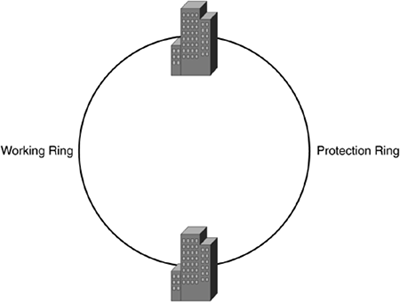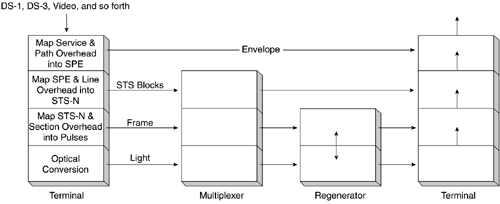SONET
The Synchronous Optical Network (SONET) standard for fiber optic networks was developed in the mid-1980s and remains in widespread use today. SONET enables the interoperation of multiple technologies and vendor products by defining standard physical network interfaces.
SONET was designed for the public telephone network, where fiber optic cabling prevailed for long-distance voice traffic transmissions. The existing networks proved expensive to build and difficult to extend for so-called long-haul data and/or video traffic.
NOTEIn Europe, the term Synchronous Digital Hierarchy (SDH) refers to essentially the same standard as SONET. This chapter uses the term SONET to refer to the common characteristics of SONET/SDH. |
The American National Standards Institute (ANSI) devised SONET as the new standard for these applications. Like Ethernet, SONET provides a physical layer (OSI Layer-1) for internetworking. As such, SONET acts as a carrier of multiple higher-level application protocols. For example, Internet Protocol (IP) packets can be carried over SONET, such as Packet over SONET (PoS).
SONET transmits data at speeds between 155 Mbps (megabits per second) and 2.5 Gbps (gigabits per second). To build these high-bandwidth data streams, SONET multiplexes together channels as low as 64 Kbps) into SONET data frames sent at fixed intervals, such as Time Division Multiplexing (TDM).
SONET is most known for enabling ring topologies in an internetwork. Figure 22-1 illustrates the SONET ring concept.
Figure 22-1. SONET Ring

The working ring handles all data traffic while the protection ring is on standby. If the working ring fails, SONET enables the automatic failure detection and transfer control so the protection ring takes over as the working ring in a short period of time, often 50 to 100 ms. It is because of this working/protection ring design that SONET is described as a self-healing network technology.
SONET Operation
Communication between different networks requires multiplexing/demultiplexing and a coding/decoding process in converting the signal from one format to another format for transmission across multiple networks. To solve this problem, SONET standardizes the rates and formats, as illustrated in the Figure 22-2.
Figure 22-2. SONET Multiplexing and Coding

Different types of formats are multiplexed to form a single SONET 51.48 Mbits/s.
STS
The Synchronous Transport Signal (STS) is the basic building block of SONET optical interfaces, with a bandwidth rate of 51.84 Mbps. The STS consists of two parts:
STS payload (carries data information)
STS overhead (carries signaling and protocol information)
At the sending (origination) end of a communication system, signals of different rates and formats are converted to an STS frame, then multiplexed together to form a single STS signal (at 51.48 Mbps). This STS signal is carried by the SONET until the receiving (termination) end converts the STS frames back into the original user format (T1, T3, and so on.)
SONET Path Elements
Figure 22-3 illustrates the conceptual components of a SONET implementation.
Figure 22-3. End-to-End SONET Elements

The following list describes the elements found in an end-to-end SONET connection.
PTE The STS path terminating equipment is the element multiplexing/demultiplexing the STS payload signal. The STS path terminating equipment assembles 28 DS1 signals and inserts path overhead forming the STS-1 signal (51.84Mbps).
LTE The LTE is the network element originating/terminating the optical (light) signal.
STE The STE is the network element that can modify, originate, regenerate, or terminate the STS signal.
SONET Layers
SONET has four optical interface layers, which are illustrated in Figure 22-4.
Figure 22-4. SONET Layers

The following list describes each SONET layer:
Path Layer Manages the transport of services between the PTE. The path layer maps the signals into a format required by the line layer.
Line Layer Manages the transport of the path layer payload and its overhead across the physical medium. The line layer provides synchronization and performs multiplexing for the path layer.
Section Layer Manages the transport of an STS-N frame across the physical medium.
Photonic Layer Manages the transport of bits across the physical medium. The photonic layer converts the STS signal and OC signals.
EAN: 2147483647
Pages: 269